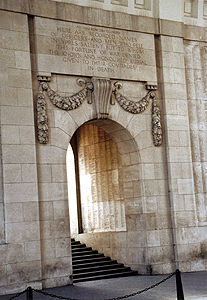The Hypo Helmet (or “Smoke Helmet”) was an early gas mask developed by Newfoundland doctor Captain Cluny Macpherson during the First World War. Macpherson began working on the Hypo Helmet after the Germany army launched its first chlorine gas attack at the Second Battle of Ypres in April 1915. The British army began issuing the Hypo Helmet to Canadian and British soldiers in May 1915. The design was soon modified, resulting in the P, PH and PHG Helmets. By war’s end, 2.5 million Hypo Helmets had been issued. The gas mask was one of the most important innovations of the First World War.

Context
On 22 April 1915 during the Second Battle of Ypres, the German army launched the first chlorine gas attack of the war, releasing approximately 160 tons of gas into the air. The cloud of yellow-green gas (about 10 km wide and 1 km deep) drifted over the Algerian (French) and Canadian lines and settled in the trenches. When the gas combined with moisture in the eyes, nose and lungs, it became an acid that caused burns and blisters. Men were blinded, and their lung tissue destroyed. Many died while most survivors suffered lifelong lung problems.
A second gas attack came two days later. Canadian troops were quickly ordered to hold cloth soaked in water or urine over their faces. This way, the chlorine would crystallize on the cloth before reaching their lungs. As gas attacks continued, the British Army struggled to protect its soldiers. On 3 May 1915, the army issued 30,000 gauze-wrapped cotton pads that were saturated in sodium bicarbonate and held over the nose and mouth. Goggles were used to protect the eyes. The next development was the Black Veil Respirator, which had a string to hold the pad in place.
Macpherson’s Design
The Black Veil Respirator was quickly replaced by the Hypo Helmet (or Smoke Helmet). It was designed by Captain Cluny Macpherson, medical officer of the First Newfoundland Regiment, who began working on the mask soon after the first gas attack on 22 April 1915. His prototype was based on a captured German helmet, which he covered with a cloth hood. The hood was a flannel bag soaked in a chemical solution, with a visor of mica. It was known as the “Hypo Helmet” because the chemical solution included sodium hyposulphite as well as sodium bicarbonate and glycerine. The hood was worn over the head and tucked in at the neck; it therefore stayed in place more easily than the Black Veil Respirator.
The British army began issuing the Hypo Helmet in May; by 6 June 1915, British and Canadian troops in France had received the new gas masks. They were also issued to Australian and New Zealand soldiers in Gallipoli in late 1915, where a Turkish gas attack was expected (but never happened).
The Hypo Helmet had several drawbacks, however. The mica visor was fragile and was soon replaced by a celluloid or cellulose acetate version. It also fogged up quickly, which made it difficult to see, while the chemical treatment irritated both the skin and eyes. The hood was also difficult to fit and made it hard to aim a weapon. The Hypo Helmet also caused headaches — likely because of a buildup of carbon dioxide, as there was no valve for either inhalation or exhalation.
Later Developments
The mask was modified as new chemical agents, particularly phosgene, were developed and used in attacks. In mid-November 1915, the Phenate (or “P”) Helmet was issued to Canadian and British soldiers. This version was soaked in sodium phenate and offered protection from the new gases. It also featured glass goggles and a tube-shaped valve. However, it soon became clear that the P Helmet didn’t protect the wearer when exposed to large concentrations of phosgene. The helmets were therefore treated with a phenate-hexamine solution and issued as the PH Helmet from January 1916; the Canadian Corps received their first PH Helmets in early February. By July 1916, the PH Helmet was the most common among British and Canadian troops in France. Another version, the Phenate-Hexamine-Goggle (PHG) Helmet, was developed for artillerymen to protect them from tear gas as well as chlorine and phosgene. The P, PH and PHG Helmets were all based on Macpherson’s design.
In 1916, a new model was developed in which the air passed through a canister of chemicals to filter out gas. The Small Box Respirator (SBR) was first issued to British troops in August 1916 and to the Canadian Corps in late November 1916. In this version, air was drawn through a filter box and decontaminated before passing into the face mask through a rubber tube. From 1917 on, soldiers were issued an SBR with a PH Helmet as backup.

Significance
In a letter dated 15 May 1915, Macpherson wrote that, “I have been lucky enough to devise the helmet which has proved most efficient for protecting against the gases without at all immobilizing the men.” Although his Hypo Helmet (or Smoke Helmet) was both basic and cumbersome, it did provide some protection to soldiers against chlorine gas. Modifications to Macpherson’s design resulted in the P, PH and PHG Helmets, which were more effective against chlorine and other deadly gases, such as phosgene. Approximately 2.5 million Hypo Helmets were distributed to soldiers, out of 55 million British gas masks produced during the First World War. Macpherson continued to work on respirator design after he returned to Newfoundland, when his focus turned from soldiers to miners’ lung problems.

 Share on Facebook
Share on Facebook Share on X
Share on X Share by Email
Share by Email Share on Google Classroom
Share on Google Classroom










